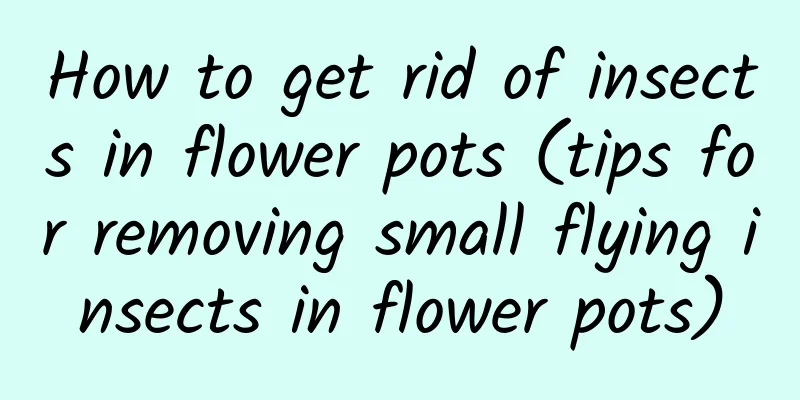Yellow leaves and rotten roots attract insects. Put some of this in the pot and it will work.

Eggshell1. Wash the eggshells, crush them and sprinkle them on the surface of the flower pot to prevent snails and slugs from eating the leaves of the flowers. Because the edges of the eggshell are very sharp, these mollusks will feel uncomfortable when crawling over the eggshell and will not crawl over to eat the leaves. 2. Eggshells contain some phosphorus, calcium and iron elements. Mixing them with soil can provide some nutrients for plant growth, promote the development of flower roots and improve plant disease resistance.Ground cinnamon1. Cinnamon powder, which is available everywhere in the kitchen, has good antibacterial activity. Therefore, when taking cuttings, if there is no rooting powder at home, you can use cinnamon powder instead, which can effectively reduce wound infection and increase the survival rate of cuttings. 2. Sprinkle cinnamon powder in flower pots or bury it in the soil. It has antibacterial and bactericidal effects. It can not only kill some harmful microorganisms and insect eggs in the soil, but also prevent ants and other insects from damaging flowers.sand1. When the temperature is high in summer, you can spread a layer of sand on the surface of the potting soil. This can lower the temperature of the potting soil to prevent the soil temperature from being too high and causing the roots of the flowers to rot. It can also prevent pests such as small black flies. 2. Mixing sand and soil together can make the potting soil loose and breathable, with good drainage, and prevent root rot. But note that the sand must be coarse sand. You can wash the sand several times to remove the dirt in the sand, and then sieve out the fine sand, and what you get is coarse sand that can be used.cinder1. Homes with stoves basically have used coal slag. After crushing the coal slag, rinse it with water. Screen out the large particles and place them at the bottom of the flowerpot to facilitate water and air permeability and prevent root rot. 2. Do not waste the remaining small particles of coal slag. You can mix them with peat soil and use them as nutrient soil. It can also play a role in loosening and ventilation, and reduce the occurrence of plant root rot.Sawdust1. It is not easy for cuttings to take root in summer. At this time, you can use pure sawdust for cuttings, such as roses, gardenias, etc. Not only do they take root faster than soil cuttings and water cuttings, but you can also move the plant and sawdust into the pot together when potting without damaging the root system. 2. You can also mix the sawdust with the soil after it is decomposed to make nutrient soil. Sawdust can be used to grow orchids instead of orchid mud, especially for the alkaline soil in the north, it can make orchids grow better.(Author: Hanghai Source: China Orchid Trading Network) Pine Needles1. The pine needles that can be found everywhere in the community are actually great for making homemade nutritious pine needle soil. Just like making sandwich biscuits, pile up layers of soil and pine needles, then water them thoroughly once more, then place them in a corner and wait for the pine needles to rot before you can use them. 2. If you think that homemade pine needle soil takes too long to use, you can just collect the pine needles and put them at the bottom of the pot. This can greatly increase the air permeability and water permeability of the pot, and naturally reduce the chance of root rot.plant ashWood ash is the residue left after burning plants and contains a lot of potassium. Mixing it with soil can not only provide potassium fertilizer for the growth of flowers, but also ensure that the soil is loose and breathable. However, wood ash is alkaline, so it is best to use less. |
<<: Miniature bonsai cultivation techniques
>>: These flowers are so cheap that they won't die no matter how much you raise them
Recommend
How to water Nepenthes
Nepenthes watering tips Nepenthes has a relativel...
Why are the leaves of the crabapple tree drying up?
1. Lack of light Reason: Begonia needs sufficient...
Can yellow jasmine survive in the soil?
1. Can it survive? Theoretically, the yellow jasm...
How many plants should be planted in one pot of Impatiens
How many Impatiens plants should be planted in on...
Is Stone Lotus poisonous?
1. Is it toxic? Don't worry, this plant is no...
Seedless Wogan planting technology and management methods (cultivation and breeding management of Wogan)
Management of Seedless Mandarin Orange Saplings T...
What is the best fertilizer for aloe vera?
Aloe Vera Fertilizer Time Aloe vera is generally ...
What to do with hydroponic daffodils in spring
Extend flowering period Spring is the time when i...
What fertilizer to use during the flowering period of camellia
1. What fertilizer to use 1. Before flower bud di...
How to grow water lilies in autumn
1. Change the water volume in time In summer, wat...
The ornamental effect of variegated trachelospermum
The ornamental value of Trachelospermum variegate...
How to grow flowers more vigorously?
Many people like to grow flowers at home, but in ...
These flowers are pruned as soon as autumn comes, and the buds keep popping up
1. Jasmine 1. In early September, most of the thi...
What is the flower of the oxalis
1. Leaves The leaves of the smilax china are swor...
How many kilograms of outdoor peppers are generally produced per mu?
There are various ways to grow peppers , includin...









